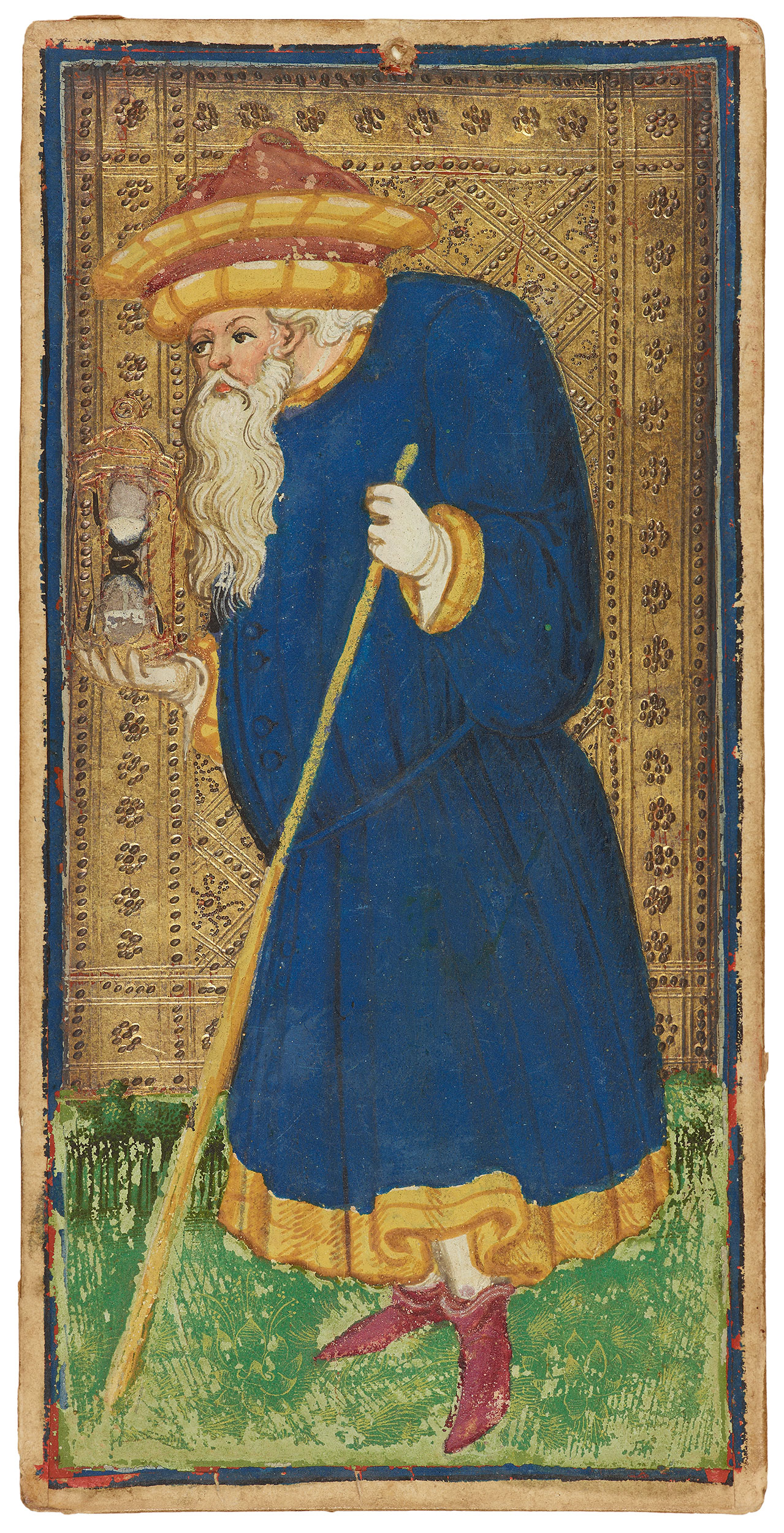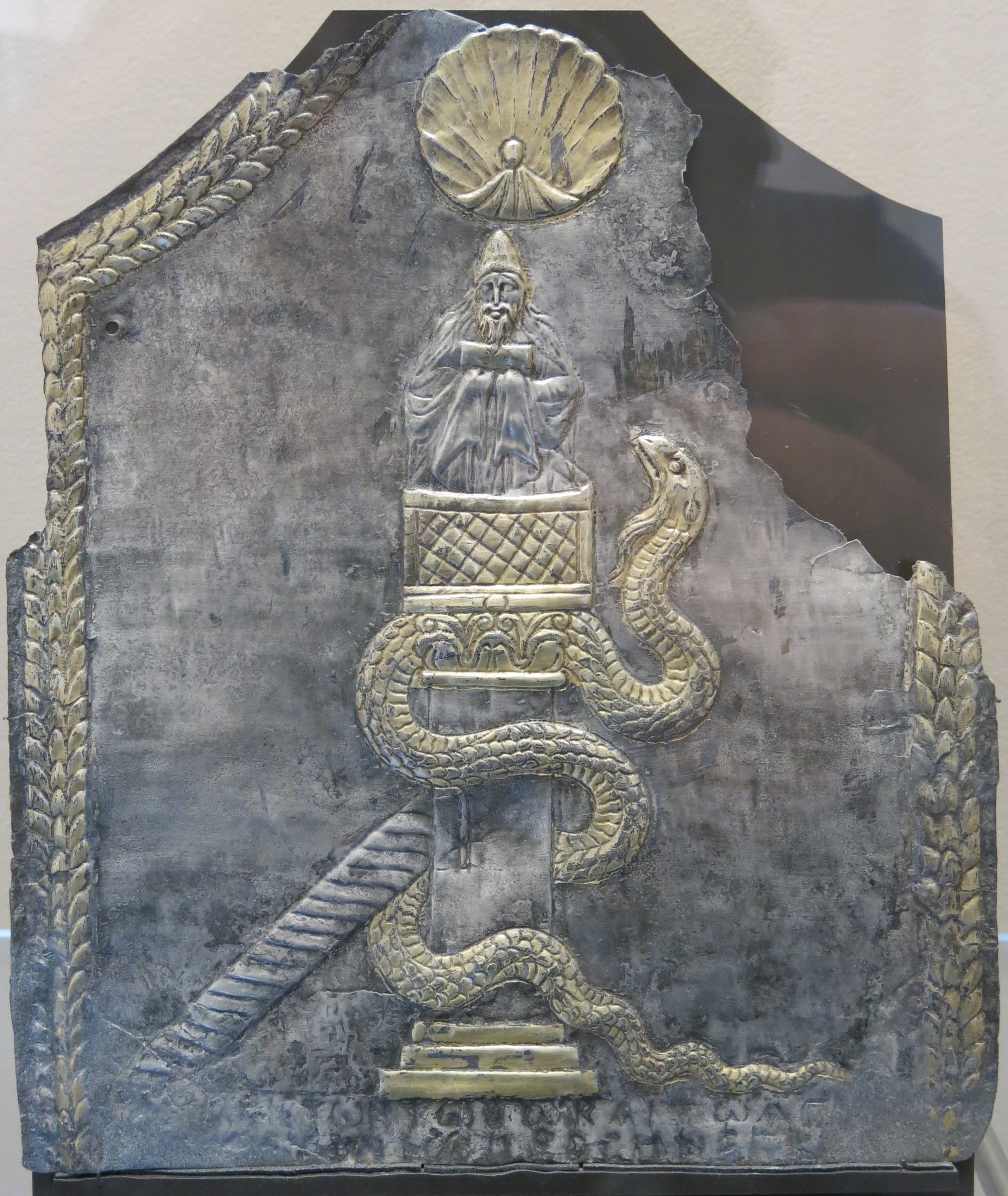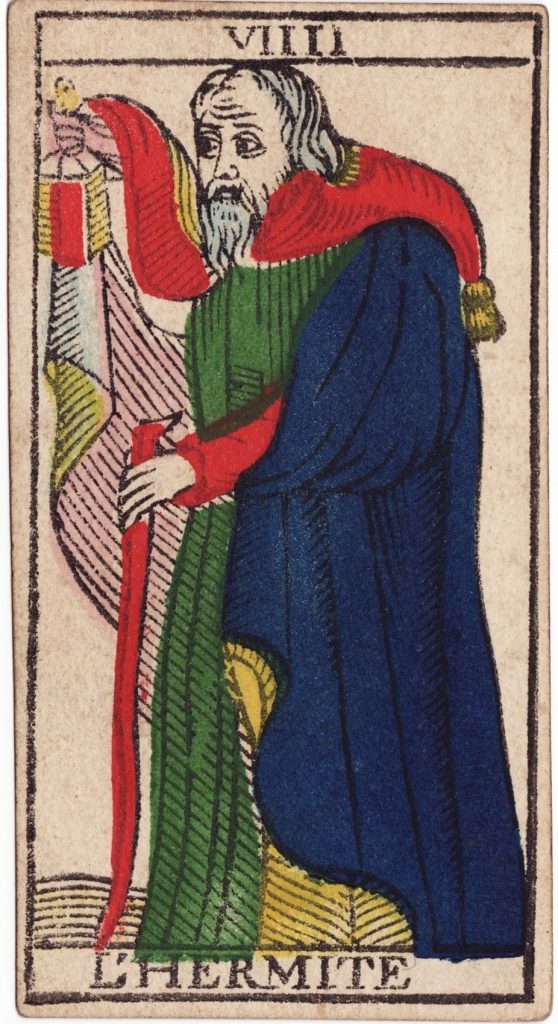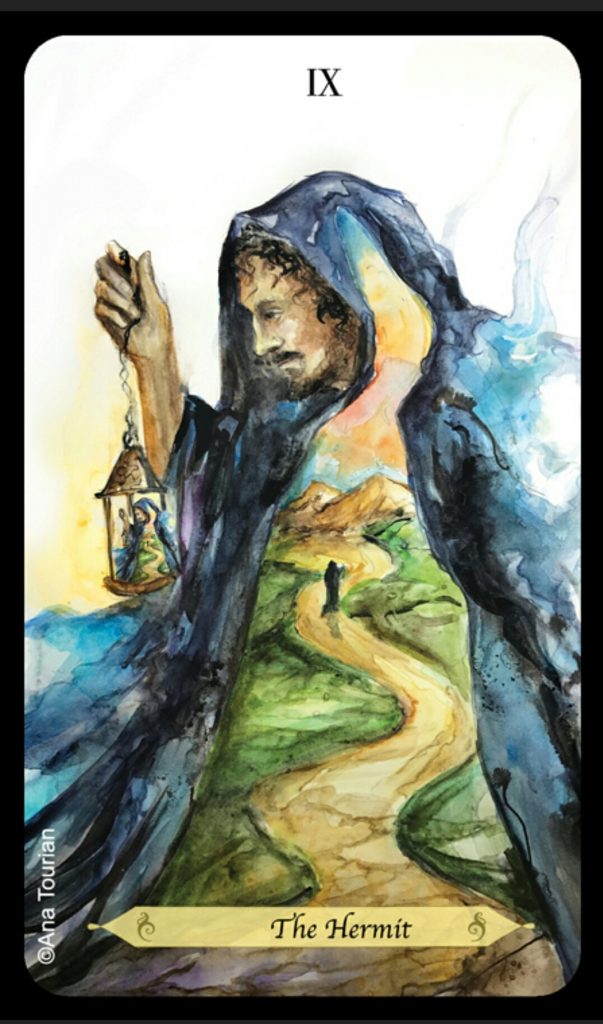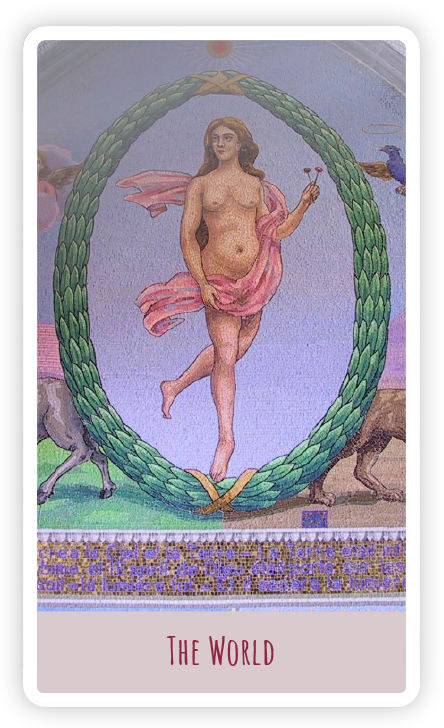9. The Hermit
God cannot be found on facebook or at a festival. To experience the divine, silence and seclusion are required. A hermit withdraws from the world and leaves his possessions behind, to find the Light. Tarot card The Hermit stands for this quest. The question is: is the man on the card still searching, or has he found what he longed for?
Hourglass
On all preserved tarot cards from the 15th century we see a man with a long gray beard and hourglass. In 16th century writings this card is called “The Old Man” or “The Hunchback.” Because of the hourglass, the card is nowadays often explained as “Father Time.” This association was intended by the artist as a cover for the actual meaning: a kundalini awakening.
Because of its shape and vertically flowing sand, an hourglass lends itself perfectly as a metaphor for the kundalini energy that flows from the pelvis to the head. Alchemical emblems from the same era confirm this interpretation (below right).
The alchemist, clothed as a monk, is (internally) purified by the kundalini energy (woman with jug and running water). The HOURGLASS in his hand represents the same process. The (divine) wing on the hourglass confirms this. The god Mercury, with CADUCEUS, pours a red liquid over the man’s head. This is the precious “Elixer of Life” (ELIXIR VITAE), pursued by the alchemist. This elixir of life is a metaphor for the changes that the brain fluid undergoes during a kundalini awakening. (Illustration from ‘Zoroaster Clavis Artis’, 1738)
It is also not difficult to see the similarity between an hourglass and an alchemist’s flasks (below and right), that on the symbolic level represent the connection in man between pelvis and head, and the energy that flows between them.
An alchemist at work in his laboratory.
From: Pyrotechnia ofte Vuur-stook-Kunde, 1687.
The fact that the Visconti-Sforza card (above left) was called “The Hunchback” at that time, and not “Father Time”, rouses suspicion that something special is indicated with his hunched back. The cards that follow in the next centuries provide more clarity about this: variants appear with an hourglass on the upper back of the man (right), and with a pillar (a universal kundalini symbol) behind him (below). We may infer from this that the hunched back on this card is a reference to an ‘awakened’ spine.
Another element on the Visconti card that could be explained as kundalini symbolism is the curious double-brimmed hat. It is problably a reference to the two energy channels (the two serpents of the caduceus) that merge in the head during the awakening process. With the hand with which he holds his staff, the old man – subtly – makes the sign of the sacred marriage (two fingers together: 2 = 1).
That these elements may be seen as symbolism is mainly motivated by the way in which the card has developed in the centuries following.
A 16th century tarot card from Italy. The arrow through the HOURGLASS is also a symbol of the kundalini energy, as we will see with tarot card 13 Death. With two fingers of his right hand the man makes the sign of the sacred marriage (2=1): in him the two energy channels (the crutches) are merged into one.
Few cards have survived from the relatively unknown Castello Ursino deck, made for Alessandro Sforza. The Hermit / Time is one of them (left). The old man on the card holds his hourglass above a pile of rocks. This means is that the kundalini has been brought “to the top of the mountain” (to the head). The six buttons on the coat of the man are a reference to the six chakras that the kundalini energy had to pass on its way to the top.
The white, knotted scarf around his waist is the so-called ‘Knot of Isis’, which symbolizes the two energy channels that merge in the head and the pineal gland. The Knot of Isis is an esoteric symbol that was frequently used in christian paintings to refer to the kundalini awakening of Jesus.
Pilar
In the iconogaphies of spiritual traditions, the pillar is frequently used as a symbol for the awakened spine. Below two examples of tarot card “Father Time”/The Hermit with a pillar behind him, at the height of his spine. Also interesting is the money pouch that the man carries at the height of his lower abdomen. This is probably a reference to the (kundalini) “treasure” in the pelvis.
The Etteilla Tarot Deck from 1789 (below left), designed by the occultist Jean-Baptiste Alliette, has its own unique numbering and interpretation of the cards. On card number 18 “Le Traitre” (The Traitor) – a name that refers to the predictive meaning of the card and not to the image – we see a monk with a high lifted burning lantern, in the style of The Hermit of the Tarot of Marseille, that we will discuss below. In front of the monk is a pillar and in the background three more pillars (the three energy channels involved in a kundalini awakening) to reinforce the symbolism.
The sun is burning in the top right corner of the card, so a lantern is not necessary. We may therefore interpret it as an inner light: the divine kundalini fire which he has ‘lifted’ (raised) to the head.
In early Christianity, hermits sometimes literally lived on a pillar. Food and water were brought up to these so-called “PILLAR SAINTS.” That this ultimate form of asceticism is rooted in symbolism can be deduced from the enormous serpent spiraling around the pillar on this plaque of Simeon de Stylite, from the Louvre (6th century).
Lantern
On the Tarot of Marseille Hermit, the hourglass has been replaced by a lantern, but the meaning of the card has remained the same. The man on the card holds the burning lantern high: he has brought the kundalini fire to his head. The lantern is half hidden behind his cloak: it is an inner light. An additional indication that we must translate the image to the interior of the Hermit, is that it is daytime on the card; a lantern is not needed.
The candle in the lantern is a red “stripe”, corresponding to the red staff: both represent the spine with the kundalini fire flowing in it. On Jean Dodal’s card, the man holds his staff with only three fingers, with the middle finger sticking out slightly. The three fingers represent the three energy channels involved in a kundalini awakening; the middle finger refers to the awakened spine (in the “center of the body”).
The card now also has a name: The Hermit – L’Ermite in French. Nicolas Conver has chosen the Old French – and at that time already unusual – spelling L’Hermite, which is probably a reference to Hermetism: a spiritual tradition related to alchemy.
The Hermit’s cloak is blue on the outside, with a red hood: the masculin (red) and the feminine (blue) energies in him are fused. The inside of the cloak is yellow/gold; a reference to the divine light that burns within him.
The alchemist follows the footsteps of Mother Nature/Sophia/the kundalini. We can deduce that this is a depiction of an inner process from the HEXAGRAM in her hand, which stands for the fusion of the polar energies. (Freymäurerische Versammlungsreden der Gold- und Rosenkreutzer des alten Systems Amsterdam, 1779)
Serpent
In the 19th century, the (kundalini) serpent explicitly appears on the scene. In the Tarot of Lomdardije card from 1810 (below left), three serpents writhe at the feet of the Hermit. Two of them are green in color, one is blue – the same color as the lantern. This is an indication that the blue serpent and the lantern symbolize the same thing: the awakened kundalini. With the hand with which the Hermit holds the lantern, he makes the sign of the sacred marriage (2=1): in him the two green serpents (energy channels) have merged.
On Oswald Wirth’s card from 1889 (below center), we see a red serpent raising itself next to the Hermit’s staff. The staff has seven “rings”: a reference to the seven chakras opened by the kundalini (the serpent).
At the top of the staff (with seven colored beads) of the Hermit of Château des Avenières (above right) an Ankh is placed; a symbol from Ancient Egypt that represents the awakened spine and pineal gland (right).
Instead of a serpent, the mosaic designer has chosen a long red sash, two ends of which are floating in the air, and a third strip of the fabric rests on the Hermit’s head. A creative way of portraying the three energy channels. The volcano in the background should confirm to us that the kundalini energy in the Hermit has awakened and ascended to his crown. The dog sitting by his staff symbolizes the sublimated (transformed) animal energies.
De Rider-Waite-Smith Tarot
A six-pointed star glows in the lantern of the RWS card. This hexagram represents the merger of the opposites. The Hermit’s staff reaches to his crown and is the same yellow-gold color as the hexagram.
The long, slender silhouette of the man and the color of his cloak are reminiscent of a pillar. This does not seem a coincidence when we place the RWS card The Tower next to it.
The Hermit stands on the top of a high mountain, considering the snow on it; a reference to his expanded consciousness. On top of a mountain you are closer to God.
Jesus also experienced a kundalini awakening, read about this in my book ‘John the Baptist who became Jesus the Christ’.
Conclusion
The card The Hermit represents the person who has completed the process of God-realization; the spiritual seeker who has reached the destination of his quest. The hourglass, lantern, pillar, staff and serpent all represent the same thing: the divine energy in the Hermit’s pelvis has awakened and now flows through his spine to his crown. From a high, snow-capped mountaintop, he looks out over the world he has conquered.
‘Whosoever overcometh, I will make him a pillar in the temple of my God,
and he will go no more from there.’
(Revelation 3:12)
Left: this artwork has been on the roof of the former Freemasons headquarters in Mendocina, California, since 1872. Its meaning is a secret that the Freemasons keep hidden from the outside world. Only at the third, highest ordination does a Freemason learn what the statue stands for. We see Father Time braiding a VIRGIN’s hair. The BRAID hangs down to her PELVIS. The girl is holding a BOTTLE and a (broken) branch of the ACACIA TREE in her hands. In front of the virgin stands a broken PILLAR. Father Time’s HOURGLASS is at her feet. I will not put the secret of the Freemasons in black and white. The reader of this article can now interpret all elements of this metaphor for the process of God-realization for himself.
The Women of Science Tarot (Matteo Farinella, 2019)
A modern version of The Hermit: the changes in the brain under the influence of a kundalini awakening scientifically visualized.
Via Tarot (U.S. Games Systems, 2003)
The Hermit stands naked (born again) on top of a pillar that is filled with (divine) light. The two serpents (energy channels) are fused. Before the birth of the new man, the old man must die; powerfully portrayed by the crucified man above the pillar, after the famous painting by Salvador Dali.
Tarot of Echoes (Ana Tourian, 2020)
The Arto Tarot (Jane Estelle Trombley, 2008: website)
The divine light flows into the human skull, through the crown chakra/third eye, and as a result of the production of amrita in the brain.
Steampunk Tarot(Uitgeverij Llewellyn, 2012)
A beautiful combination in one image of an hourglass and a lantern, with high voltage effect. On the staff are cogs that refer to the flowing kundalini.
The Wild Unknown Tarot(Kim Krans, 2012)
Beautiful photo with (vague) a lamppost exactly above the head of the monk. On the sign next to him is the appropriate text ‘informazioni portineria’ (information concierge): the Hermit can show the spiritual seeker the way.
Tarot de St. Croix (Lisa de St. Croix 2014)
The purifying (white) divine (the eye) energy flows through the spine (staff).
This article was written by Anne-Marie Wegh. Copyright November 2019.
Anne-Marie Wegh is the author of the book: John the Baptist who became Jesus the Christ

Illustrations from the tarot decks, reproduced by permission of U.S. Games Systems, Inc., Stamford, CT 06902. c. by U.S. Games Systems, Inc. All rights reserved.
Foto’s Châteaux de Avenières: http://hermetism.free.fr/Avenieres


